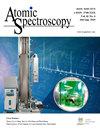Mineral Heterogeneity Of Lunar Sub-Milligram Basaltic Clasts And Its Effect On The Production Rates Of Cosmogenic Nuclides
IF 2.3
2区 化学
Q1 SPECTROSCOPY
引用次数: 0
Abstract
: Precise determination of the chemical composition of lunar samples is crucial for obtaining cosmogenic noble gas production rates and reliable cosmic ray exposure (CRE) ages. In this study, we established a new non-destructive method for determining the chemical composition of small mineralogically heterogeneous lunar basaltic clasts (<1 mg) using high-resolution X-ray microcomputed tomography (μCT). The volume of the individual mineral grains in each clast was obtained via μCT and combined with the chemical composition and density of the minerals to estimate the bulk chemical composition of each sample. The calculated chemical compositions were ultimately used to determine cosmogenic nuclide production rates. We used the lunar mare simulant sample (LMS-1) to evaluate the uncertainty of our method on the calculation of production rates of cosmogenic Ne ( 20 Ne, 21 Ne, and 22 Ne) and Ar ( 36 Ar and 38 Ar) (4% and 5% were adopted as suggested values, respectively). By applying this method to five Chang’E-5 basaltic clasts, we demonstrated that the chemical compositions of lunar regolith clastic samples (basalts) were different and the maximum variations of P 21 (the production rate of cosmogenic 21 Ne) and P 38 (the production rate of cosmogenic 38 Ar) among the five basaltic clasts were in the range of 18–20%. Therefore, the average chemical composition cannot be used to represent a single grain. In our study, mineral heterogeneity influenced the theoretical production rate of cosmogenic noble gases. Furthermore, the maximum cosmogenic 21 Ne production rate deviation from the average value reached 18.4% (~2 g/cm 2 ). Our method significantly minimized the uncertainties in the production rate calculations caused by the mineral heterogeneity of the sub-milligram samples and when applied routinely would result in more reliable CRE ages.月球亚毫克玄武岩碎屑矿物非均质性及其对宇宙核素生成速率的影响
:精确测定月球样品的化学成分对于获得宇宙成因惰性气体的产生率和可靠的宇宙射线暴露(CRE)年龄至关重要。在这项研究中,我们建立了一种新的非破坏性方法,使用高分辨率X射线微计算机断层扫描(μCT)来确定小型矿物不均匀月球玄武岩碎屑(<1 mg)的化学成分。通过μCT获得每个碎屑中单个矿物颗粒的体积,并将其与矿物的化学成分和密度相结合,以估计每个样品的整体化学成分。计算出的化学成分最终用于确定宇宙成因核素的产生率。我们使用月球模拟样品(LMS-1)来评估我们的方法在计算宇宙成因Ne(20 Ne、21 Ne和22 Ne)和Ar(36 Ar和38 Ar)(分别采用4%和5%作为建议值)生产率方面的不确定性。将该方法应用于五个嫦娥五号玄武岩碎屑中,我们证明了月球风化层碎屑样品(玄武岩)的化学成分不同,五个玄武岩碎屑中P 21(宇宙成因21 Ne的产生速率)和P 38(宇宙成因38 Ar的产生率)的最大变化在18–20%之间。因此,不能用平均化学成分来表示单个颗粒。在我们的研究中,矿物的不均匀性影响了宇宙成因稀有气体的理论产生率。此外,宇宙成因21Ne产生率与平均值的最大偏差达到18.4%(~2g/cm2)。我们的方法显著降低了亚毫克样品的矿物异质性导致的生产率计算的不确定性,并且当常规应用时,将导致更可靠的CRE年龄。
本文章由计算机程序翻译,如有差异,请以英文原文为准。
求助全文
约1分钟内获得全文
求助全文
来源期刊

Atomic Spectroscopy
物理-光谱学
CiteScore
5.30
自引率
14.70%
发文量
42
审稿时长
4.5 months
期刊介绍:
The ATOMIC SPECTROSCOPY is a peer-reviewed international journal started in 1962 by Dr. Walter Slavin and now is published by Atomic Spectroscopy Press Limited (ASPL). It is intended for the rapid publication of both original articles and review articles in the fields of AAS, AFS, ICP-OES, ICP-MS, GD-MS, TIMS, SIMS, AMS, LIBS, XRF and related techniques. Manuscripts dealing with (i) instrumentation & fundamentals, (ii) methodology development & applications, and (iii) standard reference materials (SRMs) development can be submitted for publication.
 求助内容:
求助内容: 应助结果提醒方式:
应助结果提醒方式:


